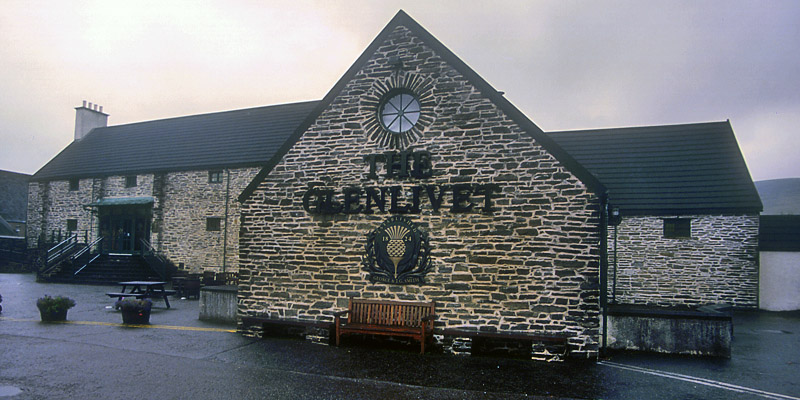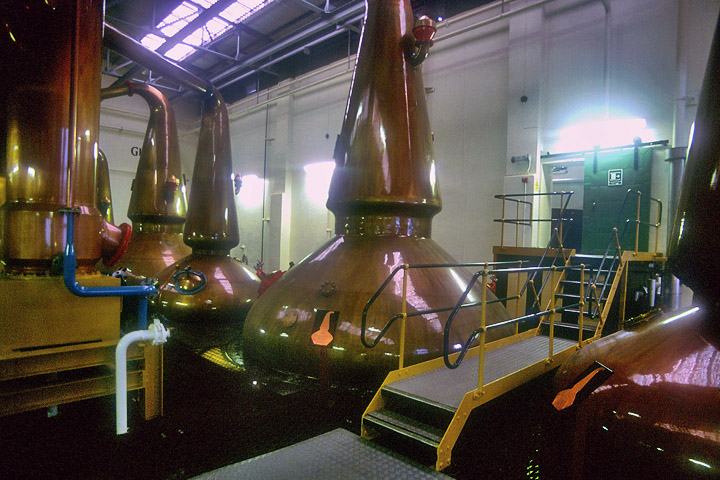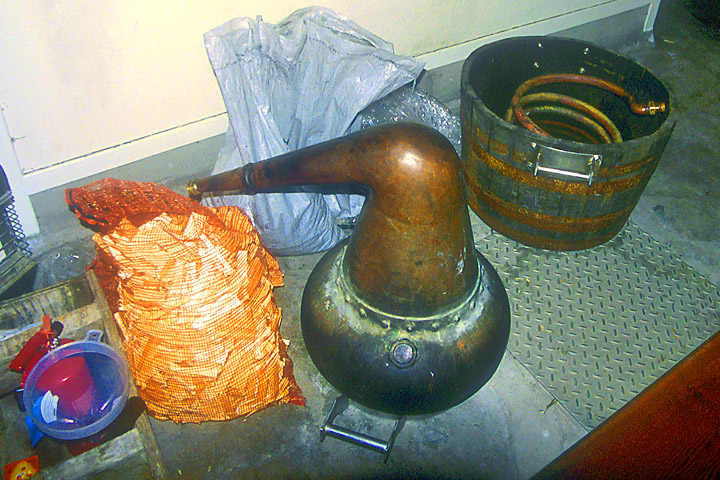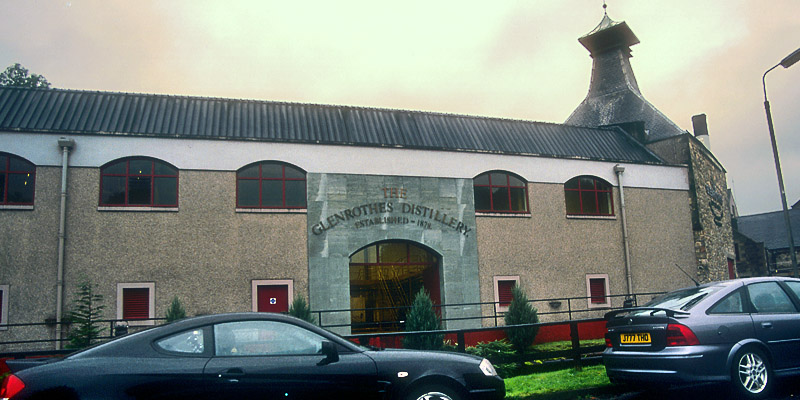
The North Atlantic Arc Home
| October |
| S | M | T | W | T | F | S |
| 3 | 4 | 5 | 6 | 7 | ||
| 8 | 9 | 10 | 11 | 12 | 13 | 14 |
| 15 | 16 | 17 | 18 | 19 | 20 | 21 |
| 22 | 23 | 24 | 25 | 26 | 27 | 28 |
| 29 | 30 |

|
|
Thursday 19 October 2006--After breakfast, I step out into a drizzly Scottish morning, only to spy Duncan Elphick supervising
a workman who is painting the trim on the Highlander.
"They say if you can't golf in the rain, you can't golf in Scotland," I say to him. "I suppose it's the same with painting the trim." "Do you golf?" he asks me. "No," I reply, and suddenly the conversation seems a bit silly. Ian arrives as promised, and off we go. The Glenlivet distillery is high up toward the end of the glen, in as wonderfully Scottish a setting as any distillery I've seen---it's very nearly up on the moor. We don't take a formal tour, but wander around the new visitor's center, where we gain an appreciation of The Glenlivet's unique place in the history of distillation. I've always rather dismissed Glenlivet as one of the two (with Glenfiddich) widely available, and therefore banal, malts, but I've learned from recent tastings that I have badly misjudged it. Very shortly I will learn just how badly. After a look around the distillery itself, Ian brings us up to the Library---I think of it as the Comfy Room---for a bit of tasting. He produces five bottles: samples of new make, and new make from the sma' still; and bottles of Nàdurra, and 1959 and 1964 vintages from the Cellar Collection. The new make is very interesting, fruity and quite drinkable, but the product of the sma' (small) still is an eye-opener. The still itself is a portable one, like those used in the days when distilling was of necessity a portable business. It was found in storage at Glenlivet, and refurbished. Special permission was needed to run it, as the government mandates a minimum size for stills, precisely to make portability impossible. The new make (it cannot legally be called whisky, as it has not matured for the mandated three years) is what the locals would have drunk prior to the legitimization of distilling; maturation was yet unknown. And the stuff is very nice, fruity and oily and not in any way harsh. I'd buy a bottle if I could. The 1959 is a stunning dram from a bottle I could never afford, and in absolute terms the oldest whisky I've ever had---I was four or five years old when it was distilled. But the '64 blows it away. Ron and I both experience one of those rare moments of utter bliss, sitting in the Comfy Room on a dreary day, sipping on ambrosia. We each have two drams, and Ian doesn't rush us. (Later we will price those two drams at about £75, but at the moment, the value is incalculable.) When we can no longer justify abusing Ian's hospitality, he takes us to a large storeroom, where we poke through piles of junk, promotional and advertising items, bits of hardware, mounted stag's heads, one complete and very sorry-looking stuffed deer, and the sma' still itself. It has handles, and two men could carry it easily. Ian could probably tuck it under his arm and walk away with it. Ian then takes us to Strathisla, often cited as the prettiest distillery in Scotland. His office is there. Our first request is a cup of coffee---we need a little respite from the drams. Ian then shows us around, and after, we have a dram of Strathisla 12. It's a nice lively malt, but pales in comparison to what we've been having. We are introduced to Tommy, a former stillman who now conducts tours. He's exactly the sort of character you'd want to take a distillery tour with, and he tells us several stories which are apparently hilarious; we have a bit of trouble with his accent. The one story I catch goes back to the days when the distillery workers were given daily drams, new make spirit to get them through the day. At one point, Strathisla's two stills were fired by different methods---one by coal, the other by steam. The men much preferred the product of the coal-fired still, and when Tommy one day gave them their drams from the steam-fired one instead, they complained bitterly. In fact, he said, he has not yet heard the end of it, even though both stills are steam-heated now, and most of the workers have long since retired. Ian then takes us on a tour of Chivas distilleries. The first is Allt-a-Bhainne. Later, we will hear it said that Caperdonich is the ugliest distillery in Speyside. For my money, the antiseptic monstrosity of Allt-a-Bhainne takes the prize. It was built in the '70s to provide bulk for blends, and is rarely seen as a single malt. The architecture of the place reminds me of ten thousand ugly strip malls I've seen, with its faux mansard roof. That said roof is covered with real slate only heightens the hideous incongruity of it. It's not fair to criticize, I suppose; the malt was never meant to be tasted on its own, and the place was never meant to be seen. We then have a look around the mothballed Glen Keith. My impression is that it's a plant that will need some sprucing up if it is to reopen. We do drive-bys of Glen Grant (a former Chivas property), Caperdonich, Glenrothes, and the disappointingly functional shop of Forsythes of Rothes, Scotland's foremost builder of stills. Ian drops us in Craigellachie at 2:30pm, and we spend the remainder of the afternoon in quiet reflection (okay, we have a good snooze) before dinner at the Highlander. We have a quiet night, with one dram at the Quaich Bar (a Rare Malts Brora for me) and retire early. We have had a splendid day, and cannot possibly thank Ian Logan enough for it. Chivas Brothers have chosen well---he is the epitome of an ambassador. We look forward to seeing him again, whether in Speyside or somewhere out in the wide world of whisky. Next |
 |
The Glenlivet
 |
Glenlivet stills
 |
The Glenlivet Lounge
 |
The Sma'Still
 |
Strathisla
 |
Strathisla stills
 |
Strathisla stills
 |
Allt-a-Bhainne
 |
Allt-a-Bhainne stills
 |
Glen Keith stills
 |
Glenrothes
Next
| October |
| S | M | T | W | T | F | S |
| 3 | 4 | 5 | 6 | 7 | ||
| 8 | 9 | 10 | 11 | 12 | 13 | 14 |
| 15 | 16 | 17 | 18 | 19 | 20 | 21 |
| 22 | 23 | 24 | 25 | 26 | 27 | 28 |
| 29 | 30 |
The North Atlantic Arc Home

Mr Tattie Heid's Mileage
Results may vary
MrTattieHeid1954@gmail.com